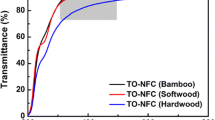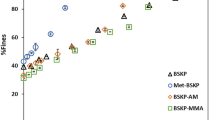Abstract
This study explores the production and surface modification of microfibrillated cellulose (MFC), based on unbleached and bleached Pinus radiata pulp fibres. Unbleached Pinus radiata pulp fibres tend to fibrillate easier by homogenisation without pre-treatment, compared to the corresponding bleached MFC. The resulting unbleached MFC films have higher barrier against oxygen, lower water wettability and higher tensile strength than the corresponding bleached MFC qualities. In addition, it is demonstrated that carboxymethylation can also be applied for production of highly fibrillated unbleached MFC. The nanofibril size distribution of the carboxymethylated MFC is narrow with diameters less than 20 nm, as quantified on high-resolution field-emission scanning electron microscopy images. The carboxymetylation had a larger fibrillation effect on the bleached pulp fibres than on the unbleached one. Importantly, the suitability of hexamethyldisilazane (HMDS) as a new alternative for rendering MFC films hydrophobic was demonstrated. The HMDS-modified films made of carboxymethylated MFC had oxygen permeability levels better than 0.06 mL mm m−2 day−1 atm−1, which is a good property for some packaging applications.







Similar content being viewed by others
References
Andresen M, Johansson L-S, Tanem BS, Stenius P (2006) Properties and characterization of hydrophobized microfibrilated cellulose. Cellulose 13:665–667
Aulin C, Gällstedt M, Lindström T (2010) Oxygen and oil barrier properties of microfibrillated cellulose films and coatings. Cellulose 17:559–574
Burton Z, Bhushan B (2005) Hydrophobicity, adhesion, and friction properties of nanopatterned polymers and scale dependence for micro- and nanoelectromechanical systems. Nano Lett 5(8):1607–1613
Chinga-Carrasco G (2011) Cellulose fibres, nanofibrils and microfibrils: the morphological sequence of MFC components from a plant physiology and fibre technology point of view. Nanoscale Res Lett 6:417
Chinga-Carrasco G, Syverud K (2010) Computer-assisted quantification of the multi-scale structure of films made of nanofibrillated cellulose. J Nanoparticle Res 12(3):841–851
Chinga-Carrasco G, Syverud K (2012) On the structure and oxygen transmission rate of biodegradable cellulose nanobarriers. Nanoscale Res Lett 7:192
Chinga-Carrasco G, Yu Y, Diserud O (2011) Quantitative electron microscopy of cellulose nanofibril structures from Eucalyptus and Pinus radiata kraft pulp fibres. Microsc Microanal 17:563–571
Chinga-Carrasco G, Tobjörk D, Österbacka R (2012) Inkjet-printed silver-nanoparticles on nano-engineered cellulose films for electrically conducting structures and organic transistors—concept and challenges. J Nanoparticle Res 14:1213
Eichhorn SJ, Dufresne A, Aranguren M, Marcovich NE, Capadona JR, Rowan SS, Weder C, Thielemans W, Roman M, Renneckar S, Gindl W, Veigel S, Keckes J, Yano H, Abe K, Nogi M, Nakagaito AN, Mangalam A, Simonsen J, Benight AS, Bismark A, Berglund LA, Peijs T (2010) Review: current international research into cellulose nanofibres and nanocomposites. J Mater Sci 45(1):1–33
Ek M, Gellerstedt G, Henriksson G (2009) Pulping chemistry and technology. In: de Gruyter W (ed) Pulp and paper chemistry and technology. ISBN: 3110213419, 459 pp
Fukuzumi H, Saito T, Iwata T, Kumamoto Y, Isogai A (2009) Transparent and high gas barrier films of cellulose nanofibers prepared by TEMPO-mediated oxidation. Biomacromolecules 10(1):162–165
Goussé C, Chanzy H, Excoffier G, Soubeyrand L, Fleury E (2002) Stable suspensions of partially silylated cellulose whiskers dispersed in organic solvents. Polymer 43(9):2645–2651
Goussé C, Chanzy H, Cerrada ML, Fleury E (2004) Surface silylation of cellulose microfibrils: preparation and rheological properties. Polymer 45(5):1569–1575
Grunert M, Winter WT (2002) Nanocomposites of cellulose acetate butyrate reinforced with cellulose nanocrystals. J Polym Environ 10(1–2):27–30
Henriksson M, Berglund LA, Isaksson P, Lindström T, Nishino T (2008) Cellulose nanopaper structures of high toughness. Biomacromolecules 9(6):1579–1585
Iwamoto S, Abe K, Yano H (2008) The effect of hemicelluloses on wood pulp nanofibrillation and nanofiber network characteristics. Biomacromolecules 9:1022–1026
Jung YC, Bhushan B (2006) Contact angle, adhesion and friction properties of micro- and nanopatterned polymers for superhydrophobicity. Nanotechnology 17(19):4970–4980
Klemm D, Kramer F, Moritz S, Lindström T, Ankerfors M, Gray D, Dorris A (2011) Nanocelluloses: a new family of nature-based materials. Angew Chem Int Ed 50:5438–5466
Lindblad M, Root A (1998) Atomically controlled preparation of silica on alumina. Stud Surf Sci Catal 118:817
Liukkonen A (1997) Contact angle of water on paper components: sessile drops versus environmental scanning electron microscope measurements. Scanning 19:411–415
Pääkkö M, Ankefors M, Kosonen H, Nykänen A, Ahola S, Österberg M, Ruokolainen J, Laine J, Larsson PT, Ikkala O, Lindström T (2007) Enzymatic hydrolysis combined with mechanical shearing and high-pressure homogenization for nanoscale cellulose fibrils and strong gels. Biomacromolecules 8(6):1934–1941
Rodionova G, Lenes M, Eriksen Ø, Gregersen Ø (2010) Surface chemical modification of microfibrillated cellulose: improvement of barrier properties for packaging applications. Cellulose 18(1):127–134
Saito T, Nishiyama Y, Putaux JL, Vignon M, Isogai A (2006) Homogeneous suspensions of individualized microfibrils from TEMPO-catalyzed oxidation of native cellulose. Biomac 7(6):1687–1691
Siró I, Plackett D (2010) Microfibrillated cellulose and new nanocomposite materials: a review. Cellulose 17(3):459–494
Siró I, Plackett D, Hedenqvist M, Ankerfors M, Lindström T (2011) Highly transparent films from carboxymethylated microfibrillated cellulose: the effect of multiple homogenization steps on key properties. J Appl Polym Sci 119(5):2652–2660
Sluiter A, Hames B, Ruiz R, Scarlata C, Sluiter J, Templeton D (2008) Determination of sugars, byproducts, and degradation products in liquid fraction process samples. Technical report, National Renewable Energy Laboratory TP 510:42623
Spence K, Venditti RA, Habibi Y, Rojas OJ, Pawlak JJ (2010a) The effect of chemical composition on microfibrillar cellulose films from wood pulps: mechanical processing and physical properties. Bioresour Technol 101:5961–5968
Spence K, Venditti RA, Habibi Y, Rojas OJ, Pawlak JJ (2010b) The effect of chemical composition on microfibrillar cellulose films from wood pulps: water interactions and physical properties for packaging. Cellulose 17:835–848
Stenstad P, Andreasen P, Tanem BS, Stenius P (2008) Chemical surface modification of microfibrillated cellulose. Cellulose 15:35–45
Syverud K, Stenius P (2009) Strength and barrier properties of MFC films. Cellulose 16(1):75–85
Syverud K, Chinga-Carrasco G, Toledo J, Toledo P (2010) A comparative study of Eucalyptus and Pinus radiata pulp fibres as raw materials for production of cellulose nanofibrils. Carbohyd Pol 84(3):1033–1038
Tasaltin N, Sanli D, Jonáš A, Kiraz A, Erkey C (2011) Preparation and characterization of superhydrophobic surfaces based on hexamethyldisilazane-modified nanoporous alumina. Nanoscale Res Lett 6:487
Turbak AF, Snyder FW, Sandberg KR (1983) Microfibrillated cellulose, a new cellulose product: properties, uses, and commercial potential. J Appl Polym Sci: Appl Polym Symp 37:815–827
Wågberg L, Decher G, Norgren M, Lindström T, Ankerfors M, Axnäs K (2008) The build-up of polyelectrolyte multilayers of microfibrillated cellulose and cationic polyelectrolytes. Langmuir 24(3):784–795
Walecka JA (1956) An investigation of low degree of substitution carboxymethylcelluloses. Tappi 39:458–463
Xhanari K, Syverud K, Chinga-Carrasco G, Paso K, Stenius P (2011) Reduction of water wettability of nanofibrillated cellulose by adsorption of cationic surfactants. Cellulose 18(2):257–270
Yang Q, Fukuzumi H, Saito T, Isogai A, Zhang L (2011) Transparent cellulose films with high gas barrier properties fabricated from aqueous alkali/urea solutions. Biomac 12:2766–2771
Author information
Authors and Affiliations
Corresponding author
Rights and permissions
About this article
Cite this article
Chinga-Carrasco, G., Kuznetsova, N., Garaeva, M. et al. Bleached and unbleached MFC nanobarriers: properties and hydrophobisation with hexamethyldisilazane. J Nanopart Res 14, 1280 (2012). https://doi.org/10.1007/s11051-012-1280-z
Received:
Accepted:
Published:
DOI: https://doi.org/10.1007/s11051-012-1280-z




